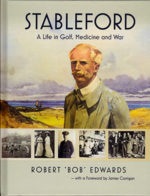Book Review
The Bulletin, September 2017, No. 212

Stableford – A Life in Golf, Medicine, and War
By Robert Edwards
2017, Ryan Publishing
ISBN 978 1 876498 60 (hardback)
236 pages, 8.5-by-11, $45 soft cover
$60 hardback, $15 shipping and handling
www.ryanpub.com.au/stableford.htm
Review by Jim Davis
Having read this thoroughly researched book on the life of Dr. Frank B.G. Stableford, I can think of no better candidate for the many qualities that have made the men, and women, of Great Britain so beloved for their strength of character and the “stiff upper lip.”
Stableford is, of course, he whose name is associated with a scoring system said to be the friend of club golfers and hackers everywhere. Simple in concept – points for bogey, par, birdie…etc., with the addition of a fraction of one’s handicap added to the total – the system enables the high handicapper to battle deep into a match without fear of early disasters removing him prematurely from the field. Stableford and Modified Stableford systems are now commonly employed for any variety of competitions.
Author Bob Edwards, a retired solicitor, compiled this welcome biography with help from several sources, including Clare Stableford, the good doctor’s granddaughter, who lives in South Africa. With a measured hand, Edwards guides us through the life of this remarkable, but quiet, man. From early medical studies, to life through three wars – The Boer War, The British Somaliland Campaign, and World War I – then to marriage and the birth of his one son, Bertram, a picture emerges of naturally modest man of generous spirit and a courageous desire to serve his country.
Throughout his life, Stableford was an avid golfer who would maintain memberships at several clubs and enjoy a low single-digit handicap. He competed in what must number hundreds of club and amateur competitions.
Curiously, says Edwards, Stableford, though his surname is enshrined in the Rules of Golf (Rule 32b), has yet to be inducted into the World Golf Hall of Fame.
The famous scoring system was first tried at Glamorganshire Golf Club in 1898, but met with little success. Stableford did not return to it until 1932 at the Wallasey Golf Club. Giving the system a little tweak, it worked well enough to enjoy welcome results, good press, and a steady growth until it has become a staple of golf club competitions everywhere.
Stableford has been described as “a British sportsman of the finest type,” and “a real English gentleman.” Always tall and erect, quiet and reserved, he exuded a particular dignity. As author Edwards says, “A strong believer in Victorian values, stoicism, courage, self-sacrifice, believing in oneself…”
Just the sort of man who would take a lifelong love of golf and create a scoring system that would allow every golfer to compete on nearly equal grounds.
A patron saint, indeed.
What would the Grand Old Man have employed had golf cars been around? I like to think it would been something like a 1956 E-Z-Go with gold and black seats, silver cowl and trim, and a basket in the back for hauling around various clubs and tools.
Golf cars, of course, did not come along in any numbers until the mid-to late 1940s, although a cartoon of them, remarkably prescient for the day, appeared in Robert Hunter’s The Book of the Links, in 1912.
Golf cars – not carts, not trolleys – before they became boring look-alikes in the 1970s, were produced in a fascinating variety of styles and have long been a passion for Canadian Ron Lyons who has acquired, it will be safe to say, the world’s foremost collection of golf cars produced between 1949-69.
His 2018 book of this unique collection, Golf Car Classics, documents in wonderful detail the many styles from glamorous to utilitarian that characterize these conveyances. It’s a large format book, the better to indulge in the color and history of these amazing cars.
There are dozens of lavish photos of the cars Lyons has found and painstakingly restored to near-mint condition. Many are accompanied by period advertisements with the ad man’s breathless pitches, which provide a sense of context for each car – not cart, it is worth repeating – and its spot in the Lyons’ pantheon of these colorful relics of yesteryear.
The earliest cars came about because one enterprising golfer or another needed a conveyance to overcome a physical impediment that otherwise would have precluded his continued enjoyment of the game.
The first electric car appeared around 1930 to aid one who had lost a leg, but whom, as chairman of his club’s green committee, needed something to get round the course. Engineers at the local power and light company designed and built an electric car for him. In 1941, a Kansas City man with a back ailment built a ‘motorized tricycle” to help get around. It was noisy and eventually banned. Not wanting to give up golf, naturally, the fellow designed a small electric version he nicknamed “the flea bug.” He even purchased a Cadillac with a trunk large enough to hold the “flea bug” and a ramp to ease loading and off-loading.
From these early goings, entrepreneurs and engineers teamed up over the next 28 years or so to produce the many colorful golf cars that have so captivated Lyons. The advertising photographs alone are worth finding this book. The reader will see countless iterations of cars, organized alphabetically by company name, from truly rickety vehicles to sophisticated cars with flowing design, some even with telephones installed for the businessman who simply cannot be out of touch with the office.
Lyons has travelled countless miles across North America to purchase rusty relics, haul them back to his shop in Edmonton and with torch, tool, paint, and determination, restore the motorized collectible to a proud and gleaming, fully operational, resurrection.
The book is a testament as much to Lyons’ passion for this surely singular hobby, as it is to his desire to share his glee in the marvelous individuality and creativity imbued in each car.
Lyons says he has identified 142 different companies that have produced more than 200 different models. He displays more than 85 such cars in his golf museum at his golf course, The Legends, in Edmonton, Alberta. Articles in past Bulletins, Through the Green and, likely other publications, too, have recorded “Mr. Lyon’s Wild Ride” through the world of golf cars. On celebratory occasions, any number of the cars will find their way onto the fairways of The Legends for a day in the sun in their originally intended setting.
Golf Car Classics is a lovely, rollicking and rolling ride through a facet of golf’s history heretofore undocumented, at least to this writer’s knowledge.
For the sheer fun of it, if even to pick up a wee bit of Lyons’ infectious enthusiasm, Golf Car Classics is a delightful volume worth finding and leaving out on the coffee table for all to enjoy.
Reviewed by Jim Davis

